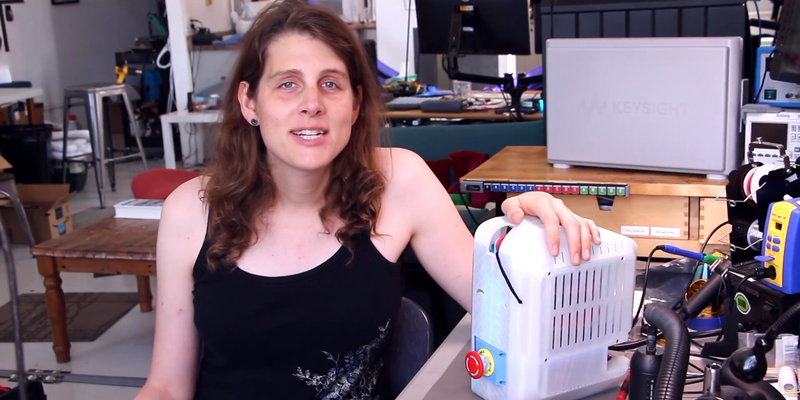Some people are better than others when it comes to documenting their hacks. Some people, like [Micah Elizabeth Scott], aka [scanlime], set the gold standard with their recordings. Hacking sessions with the Winch Bot have been streamed regularly throughout the build and this is going to lead to a stacking effect in her next projects because the Winch Bot was designed to record hacking sessions. Hacking video inception anyone? Her Winch Bot summary video is after the break.
The first part of this build, which she calls the Tuco Flyer, was [Micah Elizabeth Scott]’s camera gimbal hack which we already covered and is a wonderful learning experience in itself. She refers to the gimbal portion as the “flyer” since it can move around. The Winch Bot contains the stationary parts of the Tuco Flyer and control where the camera will be in the room.
Conceptually, attaching strings to motors is a simple idea but [Micah Elizabeth Scott] shows why it requires a lot of ingenuity and engineering to make that system usable for audio/video. Mechanical noise on the system was a problem which took a couple of iterations to solve as vibrations would travel through the cords. This might not seem like a big issue until you consider that the microphone is attached to these strings and vibrating strings are the premise of every guitar, violin, and banjo.
Each Winch Bot module contains a TM4C1294 microcontroller which was chosen for its speed, price, and included 100-base Ethernet. [Micah Elizabeth Scott] plans to control the Tuco Flyer’s movement and video recording from the same computer. We can’t help but wonder if there will be an automated routine to automatically scan objects for 3D rendering.
“Show your work” doesn’t have to be a groan-inducing statement on a math test, it should be a way to show others your efforts and hopefully someone will learn something from you. Check out another winch robot and look at our many camera hacks. Show Hackaday what you can do!

















She’s the first person I ever became a patreon of. It was after your gimbal story. I hope others will do the same
Every time I see Micah Elizabeth Scott’s name, I know I’m in for a treat. This is the woman who hacked a Wacom tablet to work as a friggin’ RFID reader using return-oriented programming, after all. She truly is an inspiration.
Maybe you just have a configuration that doesn’t work well with VMware’s USB. I don’t use VMware much so I can’t say much about how well it works in practice, but I have had good luck with Virtualbox’s USB.
The sole reason I use VMware and not Virtualbox is that the USB works for me in VMware. Could be configuration, could be not, don’t really care as it worked out of the box in VMware.
It was long time ago. People change :)
@Gunny
Why is this the hill you choose to die on? Like, I know some people with really dumb names but I don’t invent better ones for them because that would be rude and there’s just no point. Basic courtesy costs nothing, and spite gains nothing.
I used to do iPhone dev on VMware with a device plugged in via USB and never and any issues. This was 3-4 years ago.
I think she was featured on HAD when she managed to extract firmware from Wacom tablet by power glitching, that was pretty interesting. She has other cool videos, but has problem with making them shorter than 3 hours so I mostly skip them and watch only shorter ones.
She doesn’t “have a problem” with making short videos, you’re confusing the livestreams where she actually works on the project and records the footage with the scanlime videos which is the end result of editing them (like the one posted here.)
Yeah her live streams go for a really long time. I sometimes enjoy putting them on whilst I work on my own projects. Watching and listenting to someone else work helps me sometimes to keep a lighter focus but for a longer time. If you get the chance join in one of the true live streams and jump into the chat it can be surprisingly engrossing chatting with her and others about the build and hacking in general.
The live streams are almost pseudo online hacker spaces. One person does all the work whilst everyone else tells them how to do it better whilst sitting on their ass drinking coffee and skiving off.
I’d be curious to see what someone who has Synesthesia, might see by using that photoshop image method [ Micah Elizabeth Scott ] uses.
or
I also wonder about using a color highlighting based on some sort of “word length ” or bit grouping ? Similar to what is done in some compilers?
Of course there’s the old audio screech (like an old acoustic coupler).
Bottom line~ish? I like her visual approach/augmentation to making code more mentaly accessable for a humans!!!
I’m a bit sleep deprived , so apologies if this seems a bit short on sensibility.
Gonna have to watch some more of her vids .just wish I didn’t have to look at Vimeos page source and hunt the “moogaloop’ thingy to watch them.
…somethiong doesnt seem to paly well with my browser alterations?
That’s a lot of information in that video. But awesome build anyway.
8:56 of having my mind blow by her depth and diversity of knowledge. I am truly humbled.
Is there a skill she *doesn’t* have?